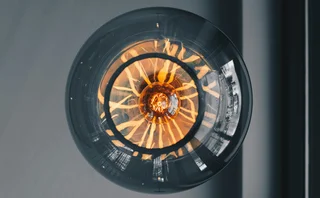One to watch: ENGIE’s CO2 battery deal with Energy Dome
Energy Risk Awards 2025: Energy firm’s pioneering offtake deal brings first full-scale CO2 battery to market

ENGIE has further boosted its growing global energy storage portfolio by partnering with long-duration energy storage (LDES) technology company, Energy Dome. Together, they are bringing the first full-scale carbon dioxide (CO2) battery to market, winning a 2025 Energy Risk One to watch award.
The battery, located in Sardinia, Italy, recycles CO2 to store energy efficiently and sustainably through a patented thermodynamic process. Once operational, in May 2025, the 20-megawatt (MW) battery will be able to provide 10 hours of continuous electricity to approximately 14,000 households.
CO2 batteries offer several benefits over traditional batteries. Their lifespan, at around 30 years, is roughly double that of lithium-ion batteries. And while slightly less efficient, CO2 battery production doesn’t involve rare minerals, reducing dependency on the tight supply chains that can sometimes constrain lithium-ion battery production.
A demonstration version of this energy storage solution, the Ottana CO2 Battery, has already attracted investment from the Bill Gates-founded private sector initiative Breakthrough Energy Catalyst and the European Investment Bank.

Once Energy Dome was ready to create a full-scale version of its CO2 battery, it needed a partner to optimise dispatch into the Italian energy markets. ENGIE fitted the bill due to its expertise in battery energy storage systems (BESS). As part of its plan to build a 10 gigawatt (GW) portfolio of battery storage assets globally by 2030, ENGIE already has more than 5GW of batteries in operation or under construction. This asset will boost ENGIE’s existing 43MW BESS portfolio in Italy.
“ENGIE’s global expertise in asset management and market shaping has been instrumental in commercialising our innovative energy storage solution,” says Francesco Oppici, co-founder and chief product officer of Energy Dome. “Our partnership validates the deployment readiness and high value creation of our patented technology.”
Alongside the innovative technology, Gaia Marana, structured green power and BESS originator at ENGIE Italia, points out that the optimisation agreement created by ENGIE is also unique in the Italian power market. “Storage systems deployment in Italy is in its early stages, but it’s growing fast, driven by both regulated and non-regulated revenue opportunities,” she explains. “Yet there is not a consolidated product for the flexibility optimisation of these assets.”
The 10-year agreement uses a profit-sharing model with a floor price. Energy Dome will continue to own the asset, land and equipment. It will handle operation, maintenance and on-site presence, while ENGIE will manage the energy trading and optimisation strategy.
ENGIE aims to maximise revenue through strategic energy trading across multiple markets, according to Alessandro Perchiazzi, head of asset optimisation and trading at ENGIE Italia. “If we see a very good spread between the highest and the lowest prices in the day-ahead market, we can open this position,” he says. “But if we see in the following markets that this spread is reduced, we can close this position. This means we can sometimes create margin without any physical operation from the asset.”
A major challenge involved understanding the likely performance of this new technology. “Our margin depends on the technical performance of the asset, but this is the first of its kind in the world, so it was very difficult to model the technical performance,” says Diego de Luca, senior long-term flexible generation portfolio manager at ENGIE Italia. Once this project is operational the team expects to see more deals like this in Italy, paving the way for more storage assets to address the intermittency challenges of renewable energy use.
In addition to supporting grid stabilisation and renewable energy integration in Italy, this project will also boost ENGIE’s growing BESS portfolio. “ENGIE is very active in the search for innovative long-duration solutions to provide flexibility to a growing renewable portfolio [that is] subject to intermittency risk,” says Roberto Ferrari, head of business development and sustainability at ENGIE Italia. “These power storage [assets] allow ENGIE to match the energy consumption profile of its clients with reshaped renewable energy.”
Beyond the benefits for the companies involved, this project also offers a template for scaling LDES technology and for optimising the dispatch of the resulting energy, which can be used in power markets around the world.
More on Awards
Environmental products house of the year: ENGIE
Energy giant signs raft of forward-thinking environmental deals in Apac
Newcomer of the year: Marex
Commodities and financial services firm expands rapidly across Apac region, entering multiple new markets
Voluntary carbon markets house of the year: Marex
Marex’s support of mangrove projects provides high-quality credits for clients and socio-economic benefits for local communities
OTC trading platform of the year: Marex
Marex’s Agile platform registers impressive volume and client growth in Asia
Technology advisory firm of the year: KWA Analytics
With a focus on strategy and scalability, KWA Analytics improves clients’ operations in Japanese power, biofuels and certificates
Commodities technology house of the year: Topaz Technology
Strong revenue growth, Asia focus and a unique approach to unifying physical and financial risk
Electricity house of the year: Provincial Electricity Authority (PEA)
Power company uses renewables to help Thailand attract energy-intensive manufacturers amid recent geopolitical shifts
Energy Risk Asia Awards 2025: the winners
Winning firms showcase the value of prudent risk management amid challenging market conditions







